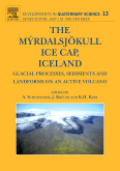
The Myrdalsjokull Ice Cap, Iceland: glacial processes, sediments and landforms on an active volcano
Schomacker, Anders
Krüger, Johannes
Kjaer, Kurt
Existing lowland ice caps are usually considered the best analogues for formerly glaciated areas and as such Icelandic glaciers have been intensively investigated with regard to process-orientated sediment-landform interrelationships. Much work has been directed towards understanding the interaction between volcanic activity and glacier response i.e. water outbursts - jökulhlhaups and sudden events of rapid flowing glacier ice, i.e. surges. The Mýrdalsjökull ice cap has served as an excellent 'ice-age' laboratory and publications are foundin all major peer-reviewed journals.The Mýrdalsjökull ice cap is located in south central Iceland and covers some 600 km2 and is centered over a large caldera hosting the Katla central volcano that encircles an area of 100 km2. Eruptions from the Katla volcanic system occur on average twice a century and belong to the most violent geological events observed associated with an enormous outburst of water with strong influence on the ice cap and surrounding areas. During eruptions, huge quantities of tephra and volcanic gasses are also emitted. The ice cap drains into several basins via a series of outlet glaciers thatterminate onto different forefields. Since the turn of the previous century Mýrdalsjökull has retreated from its Little Ice Age maximum by frontal or arealretreat only punctuated by abrupt minor advances or temporary stagnation. Either way this does provide a unique opportunity to investigate a diversity of glacial environments and its coupling to volcanic activity.
- ISBN: 978-0-444-53045-5
- Editorial: Elsevier Science
- Encuadernacion: Cartoné
- Páginas: 224
- Fecha Publicación: 19/10/2009
- Nº Volúmenes: 1
- Idioma: Inglés
